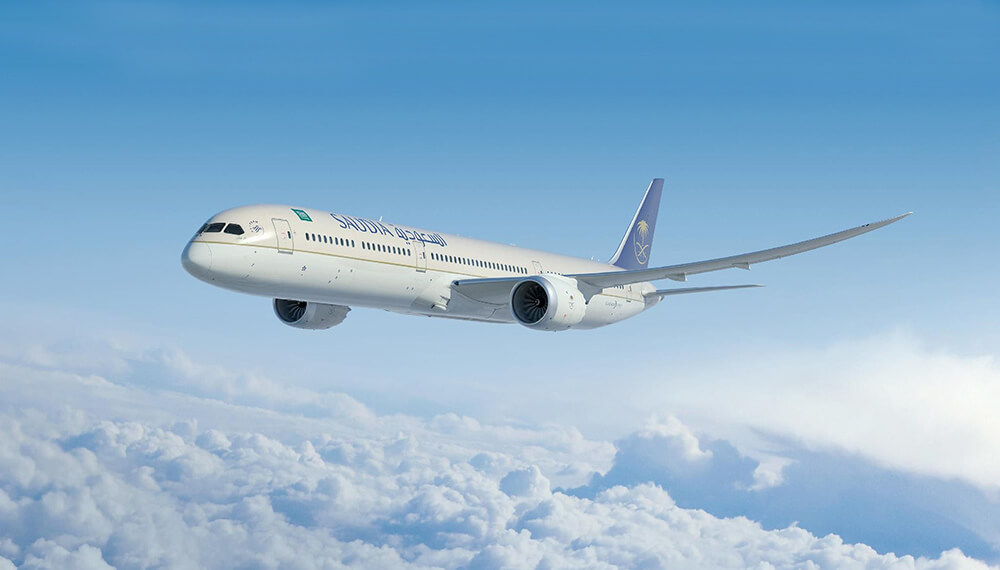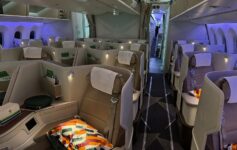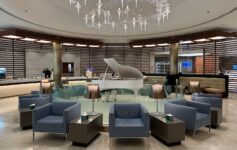
State-run Saudia, the flag carrier of Saudi Arabia, has secured funding for its massive fleet expansion plans. The addition of 73 new aircraft in the next three years will mark a cornerstone of Saudi Arabia’s plan to welcome millions of tourists from around the globe.
Saudia Fleet Expansion
In the largest financing deal in Saudi aviation history, Saudia has raised SAR 11.2 billion (USD 3 billion) to fund its aircraft expansion program. The public-private partnership includes six Saudi banks and provides the liquid capital necessary to pay for the previously-announced aircraft order, including:
- 20 Airbus A321neo
- 15 Airbus A321XLR
- 30 Airbus A320neo (for flyadeal, Saudia’s low cost subsidiary)
- 8 Boeing 787-10
Thus far, only five Boeing 787-10s have been delivered (these planes have a two-cabin configuration with 333 economy class seats and 24 lie-flat seats in business class in a reverse-herringbone configuration).
Delivery of the remaining aircraft is expected by mid 2024.
Plans For A Transformed Saudi Arabia
When I traveled to Saudi Arabia for the first time less than a decade ago, it was extremely difficult to enter. I was initially denied for a visa, but eventually secured a transit visa.
> Read More:How to Obtain a Saudi Arabian Transit Visa
Inside the Kingdom, women could not drive, restaurants had gender-segregated entrances and dining rooms, and the entire country felt unwelcoming to tourists (though I found the Saudi people quite hospitable).
But much as changed over the last few years and Saudi Arabia has revealed plans to create its own version of Dubai or Abu Dhabi in hopes of welcoming over 100 million tourists per year. The proposed development in northwest Saudi Arabia would span 10,000-square-mile (33 times bigger than New York City) and aims to attract business and industry from around the world. The city would be run on renewable energy and robotics (more details here).
By creating an oasis in the desert, Saudi Arabia hopes to generate substantial employment opportunities and significantly lessen its economic reliance on oil. But new hotels, restaurants, and office towers alone will not be enough. A flow of foreign investments will be contingent upon air connectivity and enhanced opportunities to significantly improve air travel.
This latest funding lays the groundwork to handle a surge of inbound and outbound passengers.
CONCLUSION
Saudi Arabian Airlines Corporation is now fully prepared and well-positioned to embark upon its ambitious aircraft acquisition program thanks to a fresh wave of funding. Saudia currently has a fleet of 157 aircraft (including cargo jets) and its new aircraft order will not simply replace older jets, but greatly expand the fleet.
With significantly improved air connectivity in the Kingdom, the dreams of economic diversification and attracting tourism are now one step closer.
What are your thoughts on the Saudia fleet expansion? Are you willing to visit or connecting in KSA?




Simply throwing money at a bunch of new planes ain’t gonna do it. Women still have limited freedoms, no alcohol(sorry, travelers care) and inhospitable weather during much of the year. All this leaves SA lagging the other, more experienced countries/cities in the area.
It’s an interesting first step however. Better than nothing.
“…run on renewable energy and robs…”
I think you meant “robotics”. Clearly, this article was written by a human and not a rob 🙂
and $130 for a travel visa won’t cut it for a country that has so little to offer in terms of tourism
Agreed that the visa price will need to come down.
I went to Saudi as a tourist in Nov 2019. I crossed the causeway from Bahrain to Dammam, took the train from Dammam to Riyadh, and flew to Cairo from Riyadh. Getting around was easy, everyone was really nice, but my goodness there was nothing to do. I was straight up bored. The sensation of “oh my goodness, I’m really in Saudi Arabia” wore off really quickly.
Dammam was basically just suburban Texas with wide roads, SUVs, and endless American chain restaurants. Riyadh has a very nice Hyatt Regency.
I’m glad they’re opening, but they’ve got a long way to go to truly draw large crowds from the West.
$3 billion to get the US and EU to stop harping about Jamal Khashoggi’s murder…
Hi Geoff
The article is on purchasing airlines
What part of shit hole country you live in ?
Why the negative remarks ?
The same can be said about your country.
Only good positive remark in your posting was at least “””it’s a first step. Better then nothing “”
There’s something oddly eerie about this concept. Creating a unique zone that builds an “experience” but keep you separated from the true reality of cultural immersion. It’s more Disneyesque than actual travel. No doubt it’s going to be a trend. I mean, to some extent, even in the U.S. it’s happening. The Villages in Florida is a creepy sort of preview of a living/retirement version of the same thing. I fear that future generations will just fly to places that are created as a sort of fantasy but have nothing to offer as to the genuine experience of “real” travel. Bhutan is the only one I see truly getting it right as to a semblance of control.
You’re unhappy about negative remarks and respond with – negative remarks?
@Stuart intersting discussion to be had here. I don’t think we can define “real” travel as one thing, I’m definitely one to immerse myself in the culture and reality of new places I visit, but I also understand that travel to others may mean escaping reality altogether and going to an unrealistic place ( the whole premise of theme parks is built on that).
Different people have different ideas when it comes to going somewhere new and different destinations cater to that. Dubai being a prime example to place where a “reality” is almost nonexistent and it does work for some more than others.
Believe it or not, there are people nowadays who plan a whole trip based on how “instagramable” a destination is, which is kind of sad really, but to each their own I guess.
@Aziz, It is a really interesting discussion indeed. Yes, I agree that there is an entire segment of the population that wants a walled in experience when traveling. Disney perfected the model and it appears that this will continue to evolve. Nusa Dua in Bali may have been one of the early adapters of this idea as well in a smaller sense. Seems as if the Saudi’s though will take this to a whole new level in that you enter and you stay within the confines, period. I actually support countries making efforts to product its culture and limiting mass tourism from changing its society…because it does. But I like better the approach of Bhutan. It still allows you to immerse yourself in the culture and visit remote areas to an extent, but keeps things a bit more regimented in also not flinging open the doors to millions of travelers and development companies.
The Saudi idea sounds a bit like it was inspired by the 1970’s movie, Westworld. And we all know how that ended, lol.